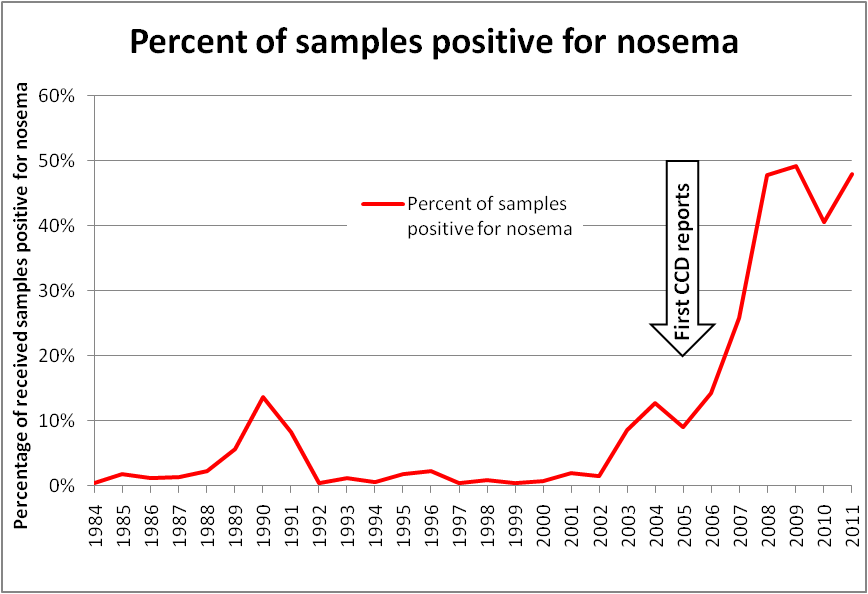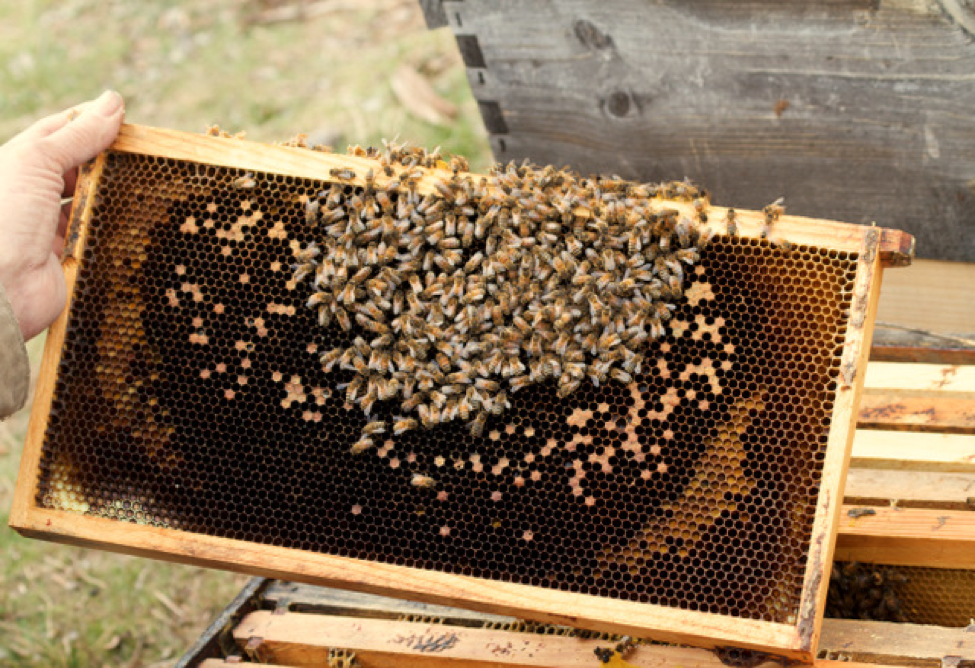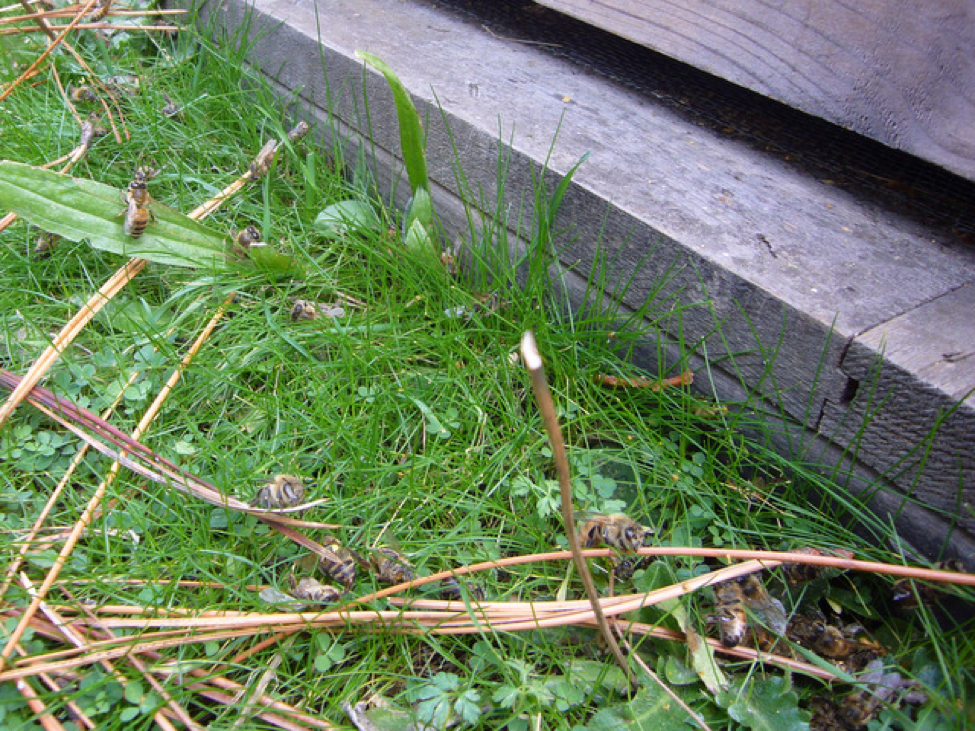The Nosema Problem: Part 2 – The Enigma of Nosema
Contents
The invasion of Nosema Ceranae. 2
How did ceranae get into the U.S.?. 5
The Nosema Problem: Part 2
The Enigma of Nosema
Randy Oliver
ScientificBeekeeping.com
First published in ABJ July 2019
I’ve recently read Raquel Martin-Hernandez’s excellent review of our state of knowledge of Nosema ceranae [[1]]. The conflicting results and interpretations from the many studies cited can make one’s head spin. And with fumagillin currently off the market, what’s a beekeeper to think or do? Last month I addressed the confusion about the association between nosema and dysentery. I’ll now continue with my own retrospective look at what I and others have learned about nosema since we discovered in 2007 that our bees had surreptitiously been invaded by a new version of this gut parasite.
As a California beekeeper, I’ve long been involved in almond pollination. So it came as quite a surprise when, in the winter of 2004/2005 there was a severe shortage of bees available to fill pollination contracts — driving the offered rental price from $45 to $155 overnight. But it didn’t really hit us just then that something may have changed in the biology of the beehive. That offered pollination fee never went back down, as beekeepers continued to struggle in the following years to keep their colonies alive. And then in 2007, beekeeper Dave Hackenberg — clear across the country in Pennsylvania, and unable to fulfill his almond contracts — brought our attention to the fact that many hives were collapsing from a strange malady subsequently referred to as “CCD” (Colony Collapse Disorder).
CCD had specific “clinical signs”: colonies going off feed, clustering strangely, and ultimately having the majority of the worker bees in a colony suddenly disappear, perhaps leaving behind a queen and a handful of nurse bees attempting to care for the remaining brood. We beekeepers were frantic in trying to figure out the cause. There were many suspects for CCD (as I’ve detailed in previous articles), but since in my own operation I could rule out the influence of pesticides, GMOs, cell phones, and likely aliens, I suspected that a new pathogen was involved.
A Red Flag: When I searched the literature for pathogens that were known to cause the dwindling or sudden depopulation of colonies without other signs, I found that nosema was the only one known to do so. So when Dr. Joe DeRisi discovered in 2007 that a new species of nosema had flown beneath the radar and invaded our colonies, it was clear that we needed to learn more about this parasite, as well as nosema in general.
Being a California beekeeper, I’d never worried about nosema. So I got a new microscope and learned how to look for it. Wow, my colonies were loaded with gazillions of spores! Could nosema be part of the CCD problem? Curious, I downloaded the data from Dave Hackenberg’s collapsed colonies from Dr. Diana Cox-Foster’s groundbreaking study on CCD [[2],[3]], and saw that his hives were also chock full of both species of nosema — so perhaps their collapse was not so mysterious after all.
The invasion of Nosema Ceranae
Nosema apis has long been considered as a cause of poor colony buildup in springtime, often associated with queen failure or signs of dysentery [[4]]. But nosema was generally only considered to be a serious problem in package bees, or in regions where cold winter and springtime weather restricted bee flight. California beekeepers (other than the package producers) tended not to worry much about nosema, perhaps in light of the survey by Doull and Eckert in 1962 [[5]], which, after finding fewer than ten percent of hives to be infected (and even then only lightly), concluded that “nosema disease was of little economic importance to the package-bee industry in California in 1961.”
Then in 1974, Eric Mussen asked beekeepers across the country to send bee samples for nosema detection, and found that it was widespread, even in California, as indicated by the map published at the time in ABJ (Fig. 1).
Figure 1. The average spore counts (in millions), and percentage of samples exhibiting infection (nearly 2/3 of the hives), in springtime of 1974 [[6]]. The authors found a positive correlation between latitude and nosema (the further north, the more nosema). Surprisingly, the percentage of colonies infected in California appeared to be much higher than in 1961. But look at the spore counts overall — in few cases did they exceed an average of 4 million spores per bee — lower than what is often observed in spring today with N. ceranae.
Practical application: Although determining the average spore count per bee in a sample can be quickly determined, it is not as biologically relevant as is the prevalence of the infection within the hive — that is, the percentage of bees infected [[7]]. I’ll elaborate later, since this difference became apparent with the invasion of N. ceranae.
Early in the CCD epizootic, Dr. Mariano Higes made a well-supported claim that N. ceranae was causing similar “colony depopulations” in Spain [[8]]. We immediately struck up regular correspondence, comparing our observations.
Curious as to where I might find further records of nosema prevalence in the U.S., I contacted Bart Smith at the USDA Bee Diagnostic Lab, since with each sample of sick bees sent to the lab, he did a quick check for the presence of nosema (not knowing at the time that there might have been two different species of the parasite present). He sent me his data; keep in mind that these samples were all from colonies that beekeepers had sent to the lab because their colony was deemed “sick.” When I graphed out Bart’s data, it stunned me (Fig. 2):
Figure 2. Plot of nosema prevalence (present or not) in samples received by the USDA Bee Disease Diagnostic Lab. Keep in mind that this data is not from random sampling, but rather from samples of sick bees sent by beekeepers to the lab, which biases the sampling toward apiaries that are having problems. This graph strongly suggests that the “invasive wave” of N. ceranae occurred between the years 2002 and 2010 — which intriguingly corresponds exactly with beekeeper reports of unexplained colony depopulations.
Oddly, this host jump (from Apis cerana to A. mellifera), and subsequent timeline of invasion by Nosema ceranae appears to have simultaneously occurred in North and South America, Europe, and Australia — all at around the same time [[9]].
Practical application: When a novel parasite invades a naïve host population, it is normal for the host population (in this case honey bees) to exhibit serious mortality during the “invasive wave” of the parasite, as natural selection weeds out those host bloodlines that are unable to mount an adequate immune response against the new parasite. The question then is, could the invasion of N. ceranae have been a player in CCD, or was its invasion merely coincidental?
Although the Higes lab published convincing research that N. ceranae was responsible for massive colony losses in Spain, I couldn’t make the case in my own mind that nosema alone was the sole culprit in the U.S., since I watched colonies of my own with mean spore counts of 5 million grow and thrive. In addition, N. ceranae didn’t appear to cause serious problems when it invaded Australia (which was free of varroa and its associated viruses), nor necessarily even in all of Spain [[10],[11]].
How did ceranae get into the U.S.?
Of interest is the detection of nosema in Mexico — a country with a relatively warm climate. Back in 1980, Wilson [[12]] took 84 samples of bees from hives in the country (some samples were composites from multiple hives). They took the samples in February and March, when nosema prevalence would be expected to be the highest, and individually dissected and inspected 10 bees from each sample. They detected nosema (presumably N. apis) spores in only 3.8% of those 840 bees — and those few infected bees had come from the mere 11% of the hives in which nosema was detected at all. Bottom line —nosema appeared to be an insignificant parasite in Mexico in 1980. But by the year 2004, N. ceranae was found to be present in 94% of 99 hives sampled [[13]]. Further investigation confirmed that by 1995 N. ceranae was already well-established in Mexico [[14]].
Practical application: Although N. ceranae didn’t really “catch hold” in the U.S. until the beginning of the century, retrospective analysis of bee samples indicates that it had been introduced somewhat earlier. We don’t know how it first got here, but it may well have invaded via Mexico. Or, back then, some beekeepers were buying unsterilized pollen from China and feeding it to their bees, which could have easily introduced the parasite (especially into the almond “mixing pot”). In any case, between 2001 and 2010, the prevalence of nosema across North America appears to have exploded.
The question then is, what does this mean to us beekeepers?
Signs of nosema infection
When my own colonies were struggling with collapse in the early 2000s, it was clear that mites, viruses, poor nutrition, and EFB were involved. But that still didn’t explain some of the sudden dwindling, and collapses down to a few bees and the queen (Fig. 3).
Figure 3. Note the recent size of the brood area, as outlined by the band of beebread, on this frame taken from a collapsing colony in February in California, when we still have frosty nights. When more than half the bees in the hive are infected with nosema, the colony may not be able to successfully complete its “spring turnover” (during which the overwintered bees must replace themselves with a new generation of workers). This may lead to the brood getting chilled overnight, and then removed by the bees the next day. What’s left are some aged and infected “winter bees” with no chance of rebuilding the colony. In a few days, there’ll be no bees left in this hive.
The above signs are similar to those noted by White for N. apis: “At times, indeed, the brood was in excess of the amount that could properly be cared for by the diminishing number of bees present.”
Practical application: A poor bee-to-brood ratio remains the field sign that makes me suspect nosema — plenty of healthy brood, but a dwindling adult population, generally occurring when the daytime temperatures are just barely warm enough for bee flight. But most of the time, I no longer see much of a problem from nosema in my hives. So yes, a high prevalence of nosema in the hive can result in poor buildup, dwindling, or even sudden collapse. But in most cases, in my climate that high prevalence does not normally occur, and the colony just “deals with” the parasite.
What puzzled me was when I carefully tracked my nosema-infected colonies in spring and early summer, most of them didn’t collapse, but went right on doing fine. Dr. Higes and I couldn’t figure out why we observed such a difference, since he had detailed how infection could eventually lead to collapse [[15]]. And then in 2010 I was asked by the Israeli startup, Beeologics, to run field tests on suppressing Israeli Acute Paralysis virus (IAPV) by applying an experimental treatment of virus-suppressing double-stranded RNA. In one impressive field trial of 72 hives that we experimentally inoculated with a nasty strain of IAPV, Dr. Eric Mussen and I, after going through the collapsing hives frame by frame at the final assessment, put our thoughts together about the stages of collapse that we had observed that day [[16]]. I went home and started putting together a diagram of how a combination of nosema, virus, and other stressors could result in sudden colony depopulation (Fig. 4).
Figure 4. In 2010, I published this hypothetical model of what occurs during colony collapse due to positive feedback loops resulting from colony stressors, viruses, and nosema. Note how the loops play into one another (asterisks), and can result in colony recovery, slow dwindling, or even rapid depopulation.
Practical application: It generally takes more than one stressor or pathogen to cause colony collapse — some combination of interactions, immune suppression, and feedback loops are generally involved. Once a colony is stressed by something else, then nosema may, due to its reductions of worker efficiency and longevity, deliver the coup de grâce to the colony by causing rapid depopulation, since the workers no longer live long enough to replace themselves. As we found with Beeologics, the combination of nosema and a virus can result in the field signs of CCD. I’ve also observed that nosema and EFB are a bad combination.
Once it came to light that we were dealing with a new species of nosema, researchers worldwide jumped into both laboratory and field investigations, and a slew of scientific papers followed. It quickly became clear that infection by nosema (of either species) causes immune suppression [[17]], metabolic stress, and reduced longevity.
Side note: Although some have suggested that the “new” species of nosema may be more pathogenic than the “old” nosema, a USDA analysis of CCD colonies by Cornman [[18]] suggests that N. apis might be the more problematic of the two.
A key finding
A number of studies have now shown that nosema-infected bees typically initiate “age of first flight” at an earlier age, and then quickly wear themselves out from increased (but inefficient) flight activity during foraging. When a bee gets infected by nosema, it becomes “energy challenged,” and may not be able to sustain long periods of flight, thus leading to more flights of shorter duration [[19], [20] ], needing to take breaks during its foraging trips, and having less chance of return from each trip [[21]] (Fig. 5). This earlier initiation of flight activity, coupled with the metabolic issues, then leads to a considerable decrease in overall worker longevity and productivity.
Figure 5. Another sign of nosema in the hive in springtime is when some foragers don’t quite make it back into the hive, and can be seen resting or crawling in front of the hive (often with pollen loads). In my experience, these bees frequently have high loads of the parasite.
Next
The more that we understand each of the parasites and pathogens that can affect our colonies, the more informed our decisions can be as to how to better manage them. In my next installment, I’ll go deeper into the reasons for the seasonality of nosema, how colonies “fight back,” and how much we should be concerned about this parasite.
citations and notes
[1] Martίn-Hernández, R, et al (2018) Nosema ceranae in Apis mellifera: a 12 years postdetection perspective. Environmental Microbiology 20(4): 1302–1329.
[2] Cox-Foster, DL, et al. (2007) A metagenomic survey of microbes in honey bee colony collapse disorder. Science 318(5848): 283-287
[3] http://science.sciencemag.org/content/sci/suppl/2007/09/06/1146498.DC1/Cox-Foster_SOM.pdf Table S1.
[4] Farrar, C.L. (1947) Nosema losses in package bees as related to queen supersedure and honey yields. J Economic Entomol 40: 333–338.
[5] Doull, K & J Eckert (1962) A survey of the incidence of nosema disease in California. Journal of Economic Entomology 55(3): 313-317.
[6] Mussen, E, B. Furgala, & R Hyser. (1974) Enzootic levels of Nosema disease in the continental United States. American Bee Journal 115(2):48-50.
[7] White, GF (1919) Nosema disease. U.S. Dept Agric Bulletin 780, 59 pp. Available in Google Books.
[8] Higes, M, et al. (2005) El síndrome de despoblamiento de las colmenas en España, Consideraciones sobre su origen, Vida Apícola 133: 15-21.
[9] Klee, J, et al (2007) Widespread dispersal of the microsporidian Nosema ceranae, an emergent pathogen of the western honey bee, Apis mellifera, J. Invertebr. Pathol. 96: 1–10.
[10] Pers. comm. Antonio Pajuelo in Spain.
[11] Fernández, J, et al (2012) Asymptomatic presence of Nosema spp. in Spanish commercial apiaries. J. Invertebr. Pathol. 111, 106–110.
[12] Wilson, WT & RA Nunamaker (1983) The incidence of Nosema apis in honeybees in Mexico. Bee World, 64(3): 132-136.
[13] Guzman-Novoa, E, et al (2011) Nosema ceranae has parasitized Africanized honey bees in Mexico since at least 2004. Journal of Apicultural Research 50(2): 167-169.
[14] Guerrero-Molina, C, et al (2016) Nosema ceranae is an old resident of honey bee (Apis mellifera) colonies in Mexico, causing infection levels of one million spores per bee or higher during summer and fall. Journal of Invertebrate Pathology 141: 38-40.
[15] Higes, M, et al (2008) How natural infection by Nosema ceranae causes honeybee colony collapse, Environmental Microbiology, 34(10): 2659-2669.
[16] https://scientificbeekeeping.com/sick-bees-part-2-a-model-of-colony-collapse/
[17] Li, W, et al (2018) Chronic Nosema ceranae infection inflicts comprehensive and persistent immunosuppression and accelerated lipid loss in host Apis mellifera honey bees. Int. J. Parasitol. https://doi.org/10.1016/j.ijpara.2017.11.004
[18] Cornman, RS, et al. (2012) Pathogen webs in collapsing honey bee colonies. PLoS ONE 7(8): e43562. doi:10.1371/ journal.pone.0043562
[19] Dosselli, R, et al (2016) Flight behaviour of honey bee (Apis mellifera) workers is altered by initial infections of the fungal parasite Nosema apis. Scientific Reports DOI: 10.1038/srep36649
[20] Dussaubat,C, et al (2013) Flight behavior and pheromone changes associated to Nosema ceranae infection of honey bee workers (Apis mellifera) in field conditions. Journal of Invertebrate Pathology 113(1): 42-51.
[21] Wolf, S, et al (2014) So near and yet so far: harmonic radar reveals reduced homing ability of nosema infected honeybees. PLoS ONE 9:e103989.








